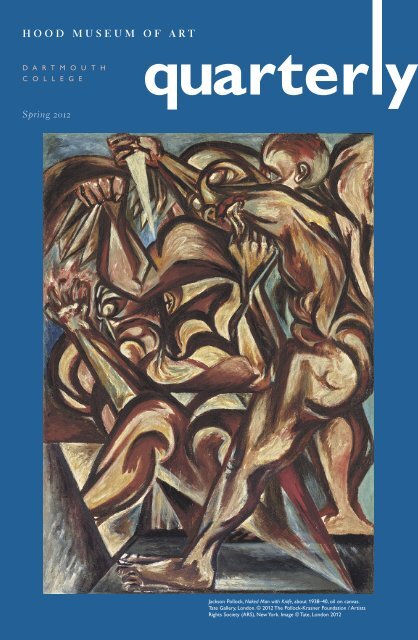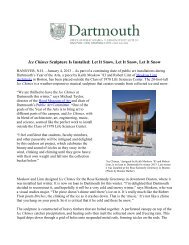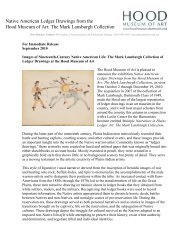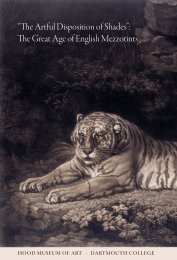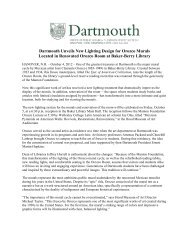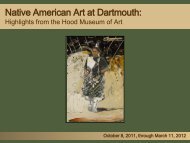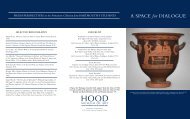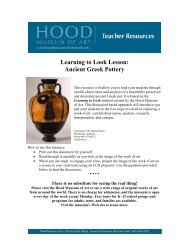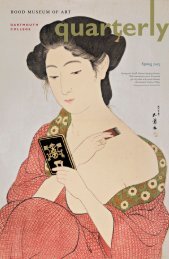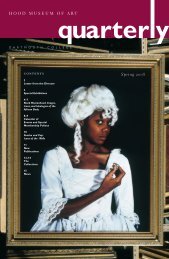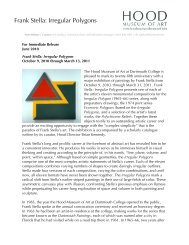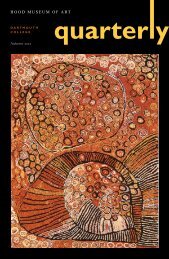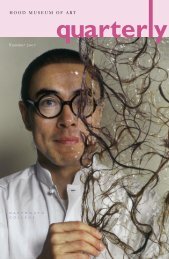Spring 2012 - Hood Museum of Art - Dartmouth College
Spring 2012 - Hood Museum of Art - Dartmouth College
Spring 2012 - Hood Museum of Art - Dartmouth College
Create successful ePaper yourself
Turn your PDF publications into a flip-book with our unique Google optimized e-Paper software.
H O O D M U S E U M O F A R T<br />
D A R T M O U T H<br />
C O L L E G E<br />
quarter y<br />
<strong>Spring</strong> <strong>2012</strong><br />
Jackson Pollock, Naked Man with Knife, about 1938–40, oil on canvas.<br />
Tate Gallery, London. © <strong>2012</strong> The Pollock-Krasner Foundation / <strong>Art</strong>ists<br />
Rights Society (ARS), New York. Image © Tate, London <strong>2012</strong>
HOOD MUSEUM OF ART STAFF<br />
Director Michael Taylor in front <strong>of</strong> Régis François Gignoux’s New Hampshire (White Mountain<br />
Landscape), about 1864, in the <strong>Hood</strong>’s Sack Gallery.<br />
LETTER FROM THE DIRECTOR<br />
Iwrite this letter with the good news that the <strong>Hood</strong> Quarterly is reverting to its traditional<br />
quarterly format. In recent years the magazine has appeared only twice a year, but<br />
this has proved inadequate to convey to you, our visitors, the true range and quality<br />
<strong>of</strong> our exhibitions and programs. I am therefore delighted to again publish it four times a<br />
year, starting with this issue, which highlights a lively roster <strong>of</strong> exhibitions, installations,<br />
acquisitions, and public programs for you to enjoy this spring.<br />
Opening April 7, the must-see exhibition Men <strong>of</strong> Fire: José Clemente Orozco and<br />
Jackson Pollock celebrates the one hundredth anniversary <strong>of</strong> Pollock’s birth and the eightieth<br />
anniversary <strong>of</strong> Orozco’s arrival at <strong>Dartmouth</strong> <strong>College</strong> to begin work on his celebrated<br />
mural The Epic <strong>of</strong> American Civilization, which he completed in 1934. Two years<br />
later, Pollock traveled from New York to see this monumental fresco, which inspired a<br />
number <strong>of</strong> his subsequent paintings and drawings. These works will be on display at the<br />
<strong>Hood</strong> through June 17, and I hope you will take the opportunity to visit this international<br />
loan exhibition, featuring two <strong>of</strong> the greatest artists <strong>of</strong> the twentieth century. Opening<br />
April 21, we have Nature Transformed: Edward Burtynsky’s Vermont Quarry Photographs<br />
in Context. I strongly urge you to see these huge and impressive photographs <strong>of</strong> granite<br />
and marble quarries in an exhibition that also explores the history and geology <strong>of</strong> our<br />
region. Two other exhibitions opening in April, The Expanding Grid and Marcel<br />
Duchamp: The Box in a Valise, showcase the <strong>Hood</strong>’s important collection <strong>of</strong> modern and<br />
contemporary art. Together, these exhibitions, and the related public programming,<br />
make the <strong>Hood</strong> a wonderful place for you to visit this spring.<br />
Beyond its exhibitions and programs, the <strong>Hood</strong> <strong>Museum</strong> <strong>of</strong> <strong>Art</strong> has been heralded<br />
as a model teaching museum since it opened in 1985. The focus <strong>of</strong> our teaching mission<br />
is the direct engagement with original works <strong>of</strong> art, and we provide this opportunity to<br />
thousands <strong>of</strong> <strong>Dartmouth</strong> students and local school children each year. It therefore gives<br />
me immense pleasure to announce that the Charles H. <strong>Hood</strong> Foundation has endowed<br />
the curator <strong>of</strong> education position at the museum. Lesley Wellman, who has served in<br />
this role with great dedication and accomplishment for more than twenty years, has<br />
assumed the new title <strong>of</strong> <strong>Hood</strong> Foundation Curator <strong>of</strong> Education, effective immediately.<br />
We are deeply grateful to the <strong>Hood</strong> Foundation and to Charles and Judy <strong>Hood</strong> for their<br />
leadership and vision in endowing this position and ensuring that excellence in teaching<br />
will always remain a core value at this museum.<br />
It is above all the museum’s teaching mission that guides our plans for the <strong>Hood</strong>’s<br />
upcoming expansion into the adjacent Wilson Hall building on campus, which will provide<br />
us with new galleries and classrooms. An important goal <strong>of</strong> this expansion is to create<br />
an ideal learning environment for all <strong>of</strong> our visitors, with state-<strong>of</strong>-the-art galleries containing<br />
dedicated display spaces for important areas <strong>of</strong> the collection not currently on<br />
view, as well as new classrooms equipped with smart technology. The next few years are<br />
set to be an exciting time at the <strong>Hood</strong> <strong>Museum</strong> <strong>of</strong> <strong>Art</strong>, and I look forward to sharing our<br />
progress on this important project with you in future issues <strong>of</strong> the <strong>Hood</strong> Quarterly. I also<br />
look forward to meeting you when you next come to the museum and trust that your<br />
visit will be an enjoyable one.<br />
M I C H A E L TAY L O R<br />
Director<br />
Susan Achenbach, <strong>Art</strong> Handler<br />
Gary Alafat, Security/Buildings Manager<br />
Jonathan Benoit, TMS Project/Digital Asset Manager<br />
Juliette Bianco, Assistant Director<br />
Lindsey Dewar, Assistant to the Director<br />
Patrick Dunfey, Exhibitions Designer/Preparations<br />
Supervisor<br />
Rebecca Fawcett, Registrarial Assistant<br />
Nicole Gilbert, Exhibitions Coordinator<br />
Stephen Gilchrist, Curator <strong>of</strong> Indigenous<br />
Australian <strong>Art</strong><br />
Cynthia Gilliland, Assistant Registrar<br />
Katherine Hart, Associate Director and Barbara C.<br />
and Harvey P. <strong>Hood</strong> 1918 Curator <strong>of</strong> Academic<br />
Programming<br />
Deborah Haynes, Data Manager<br />
Anna Ingraham, Security Guard<br />
Alfredo Jurado, Security Guard<br />
Amelia Kahl, Coordinator <strong>of</strong> Academic Programming<br />
Rebecca Karp, Assistant Curator <strong>of</strong> Education<br />
Adrienne Kermond, Tour Coordinator<br />
Vivian Ladd, <strong>Museum</strong> Educator<br />
Barbara MacAdam, Jonathan L. Cohen Curator<br />
<strong>of</strong> American <strong>Art</strong><br />
Nancy McLain, Business Manager<br />
Neely McNulty, Images and <strong>Art</strong>Start Instructor<br />
Nils Nadeau, Communications and Publications<br />
Manager<br />
Allen Newton, Security Guard<br />
Kathleen O’Malley, Associate Registrar<br />
Julie Ann Otis, Development and Membership<br />
Coordinator<br />
Robert Oxman, Security Guard<br />
Alison Palizzolo, Public Relations Assistant<br />
Sarah Powers, Assistant Curator for Special Projects<br />
Sharon Reed, Programs and Events Coordinator<br />
John Reynolds, Lead Preparator<br />
Mary Ellen Rigby, Gift Shop Manager<br />
Essi Rönkkö, Assistant Curator for Special Projects<br />
Margaret Spicer, Adjunct Curator <strong>of</strong> the Henry B.<br />
Williams Costume Collection<br />
Michael Taylor, Director<br />
Sheldon Tefft, Security Guard<br />
T. Barton Thurber, Curator <strong>of</strong> European <strong>Art</strong><br />
Lesley Wellman, Assistant Director and<br />
<strong>Hood</strong> Foundation Curator <strong>of</strong> Education<br />
Kathryn Whittaker, Security Guard<br />
Janet Whyte, Security Guard<br />
Matthew Zayatz, Preparator<br />
<strong>Dartmouth</strong> <strong>College</strong><br />
Hanover, New Hampshire 03755<br />
(603) 646-2808<br />
www.hoodmuseum.dartmouth.edu<br />
<strong>Hood</strong> Quarterly #33 (<strong>Spring</strong> <strong>2012</strong>)<br />
Edited by Nils Nadeau<br />
Designed by Joanna Bodenweber<br />
Printed by Capital Offset Company<br />
© <strong>2012</strong> Trustees <strong>of</strong> <strong>Dartmouth</strong> <strong>College</strong><br />
2 H O O D Q U A R T E R L Y
S P E C I A L<br />
exhibitions<br />
MEN OF FIRE:<br />
JOSÉ CLEMENTE OROZCO AND JACKSON POLLOCK<br />
April 7–June 17, <strong>2012</strong><br />
During the summer <strong>of</strong> 1936, Pollock traveled to <strong>Dartmouth</strong> <strong>College</strong> to view Orozco’s recently<br />
completed mural The Epic <strong>of</strong> American Civilization (1932–34).The deep impact that its imagery had<br />
on the young artist is demonstrated by the drawings and oil paintings that Pollock made after his<br />
visit, in which he explored Orozco-inspired themes such as myth, ritual, and the creative and<br />
destructive power <strong>of</strong> fire. Rarely seen preparatory studies that the Mexican muralist made as an<br />
artist-in-residence at <strong>Dartmouth</strong> are shown alongside Pollock’s paintings and drawings in this<br />
revelatory juxtaposition <strong>of</strong> two <strong>of</strong> the most famous artists <strong>of</strong> the twentieth century.<br />
The exhibition and catalogue were organized by the <strong>Hood</strong> <strong>Museum</strong> <strong>of</strong> <strong>Art</strong> in partnership with the Pollock-Krasner House<br />
and Study Center.The catalogue was supported by Judith and Richard Steinberg, Class <strong>of</strong> 1954, and the exhibition at the<br />
<strong>Hood</strong> was made possible by Jan Seidler Ramirez, Class <strong>of</strong> 1973, Kate and Yaz Krehbiel, Class <strong>of</strong> 1991,Thayer 1992, and<br />
the William B. Jaffe and Evelyn A. Hall Fund.<br />
José Clemente Orozco, study for “The Departure <strong>of</strong> Quetzalcoatl” (panel 7) from The Epic <strong>of</strong> American<br />
Civilization, about 1932–34, gouache on paper. Purchased through gifts from Kirsten and Peter Bedford, Class <strong>of</strong><br />
1989P; Jane and Raphael Bernstein;Walter Burke, Class <strong>of</strong> 1944; Mr. and Mrs. Richard D. Lombard, Class <strong>of</strong> 1953;<br />
Nathan Pearson, Class <strong>of</strong> 1932; David V. Picker, Class <strong>of</strong> 1953; Rodman C. Rockefeller, Class <strong>of</strong> 1954; Kenneth<br />
Roman Jr., Class <strong>of</strong> 1952; and Adolph Weil Jr., Class <strong>of</strong> 1935;W.988.52.82.<br />
NATURE TRANSFORMED: EDWARD BURTYNSKY’S<br />
VERMONT QUARRY PHOTOGRAPHS IN CONTEXT<br />
April 21–August 19, <strong>2012</strong><br />
Quarries constitute one <strong>of</strong> the important subjects <strong>of</strong> internationally renowned artist<br />
Edward Burtynsky’s photographic oeuvre. His images <strong>of</strong> Vermont quarries, both active and<br />
abandoned, are particularly striking. At the same time they allude to the marble and granite<br />
industry, a lesser-known aspect <strong>of</strong> New England’s history and geology.This exhibition<br />
features both Burtynsky’s photographs <strong>of</strong> the quarries <strong>of</strong> Vermont, some <strong>of</strong> which are on<br />
display for the first time, and vintage photographs pertaining to the early history <strong>of</strong> these<br />
sites, especially regarding the Italian stoneworkers in the marble quarries around Rutland<br />
and the granite quarries near Barre.<br />
This exhibition was organized by the <strong>Hood</strong> <strong>Museum</strong> <strong>of</strong> <strong>Art</strong> and generously supported by Raphael and Jane<br />
Bernstein / Parnassus Foundation, Laurie Jean Weil D.V.M. in honor <strong>of</strong> her parents, Jean and Bucks Weil, <strong>Dartmouth</strong><br />
Class <strong>of</strong> 1935, the Marie-Louise and Samuel R. Rosenthal Fund, and the Ray Winfield Smith 1918 Fund.<br />
Edward Burtynsky, Rock <strong>of</strong> Ages #1, Active Section, E. L. Smith Quarry, Barre,Vermont, 1991. Photograph<br />
courtesy Howard Greenberg & Bryce Wolkowitz, New York / Nicholas Metivier,Toronto.<br />
MODERN AND CONTEMPORARY ART: TWO INSTALLATIONS<br />
April 7–August 26, <strong>2012</strong><br />
These installations were made possible by the Cissy Patterson Fund and the Hansen Family Fund.<br />
Marcel Duchamp:The Box in a Valise<br />
Duchamp described his Boîte-en-valise as a “portable museum” that would allow him to carry<br />
around his life’s work in a traveling box. He assembled facsimiles <strong>of</strong> his major paintings, drawings,<br />
and sculpture in imitation-leather boxes, and the <strong>Hood</strong>’s example is shown at <strong>Dartmouth</strong> <strong>College</strong><br />
for the first time in this exhibition.<br />
The Expanding Grid<br />
This exhibition explores the legacy <strong>of</strong> cubism and other forms <strong>of</strong> grid-based abstraction.<strong>Art</strong>ists<br />
such as Mark Rothko, Chuck Close, Eva Hesse, and Lee Bontecou expanded the modernist grid in<br />
pr<strong>of</strong>ound ways to create works <strong>of</strong> art that embrace political content, figuration, narrative, and<br />
subjectivity.<br />
Eva Hesse, Untitled, 1964, opaque and transparent watercolor, pen and black ink, felt-tip marker, and crayon on<br />
wove paper. Purchased through gifts from the Lathrop Fellows;W.2004.1 © Estate <strong>of</strong> Eva Hesse / Hauser &<br />
Worth, London and Zurich<br />
EGYPTIAN ANTIQUITIES AT DARTMOUTH: HIGHLIGHTS FROM THE HOOD MUSEUM OF ART<br />
Ongoing<br />
This exhibition was organized by the <strong>Hood</strong> <strong>Museum</strong> <strong>of</strong> <strong>Art</strong> and generously supported by Kate and Yaz Krehbiel, Class <strong>of</strong> 1991,<br />
Thayer 1992, and the William B. Jaffe and Evelyn A. Hall Fund.<br />
3
MEN OF FIRE<br />
JOSÉ CLEMENTE OROZCO AND<br />
JACKSON POLLOCK<br />
This spring, the <strong>Hood</strong> <strong>Museum</strong> <strong>of</strong> <strong>Art</strong> will join in a<br />
worldwide celebration <strong>of</strong> the centenary <strong>of</strong> Jackson<br />
Pollock’s birth in 1912. In partnership with the Pollock-<br />
Krasner House and Study Center, the museum<br />
presents Men <strong>of</strong> Fire: José Clemente Orozco and Jackson<br />
Pollock, an exhibition that explores the deep impact<br />
that Orozco’s murals had on this emerging artist. The<br />
exhibition also marks the eightieth anniversary <strong>of</strong><br />
<strong>Dartmouth</strong>’s famous mural The Epic <strong>of</strong> American<br />
Civilization, which Orozco began painting for Baker<br />
Library’s reserve reading room in 1932.<br />
In the summer <strong>of</strong> 1936, twenty-fouryear-old<br />
Jackson Pollock made the trip<br />
from New York City to <strong>Dartmouth</strong><br />
<strong>College</strong> to see Orozco’s recently completed<br />
mural cycle. The mural was a revelation<br />
to the American artist, and in the<br />
years following this trip, Pollock engaged<br />
with themes found in Orozco’s masterpiece,<br />
including myth, ritual, sacrifice,<br />
and the creative and destructive power<br />
<strong>of</strong> fire. Men <strong>of</strong> Fire assembles the paintings,<br />
drawings, and prints that Pollock<br />
created following his trip to <strong>Dartmouth</strong>.<br />
Most were made between 1938 and<br />
1941, at a time when Pollock’s engagement<br />
with Orozco’s art was most pronounced.<br />
The exhibition provides a<br />
unique opportunity not only to see many<br />
<strong>of</strong> these works together for the first time<br />
but also to compare them with the<br />
Orozco mural that inspired them, just a<br />
short walk away across the <strong>Dartmouth</strong><br />
Green. The mural will be represented<br />
in the exhibition by several rarely seenpreparatory<br />
studies—drawings in pencil,<br />
charcoal, and gouache (fig. 1; see also<br />
p. 3)—that will present the work <strong>of</strong> these<br />
two great modern artists side-by-side.<br />
Pollock’s painting Untitled (Bald<br />
Woman with Skeleton), about 1938–41<br />
(fig. 2), is perhaps the best example <strong>of</strong><br />
Pollock’s fascination with the <strong>Dartmouth</strong><br />
mural and displays many <strong>of</strong> the elements<br />
<strong>of</strong> Orozco’s work that most appealed to<br />
him. The painting depicts a skeletal figure<br />
with an ambiguous, hybrid anatomy<br />
lying across a white, stage-like ledge, as<br />
a female figure crouches above. Skulllike<br />
faces fill the background, an audience<br />
to the work’s macabre drama. The<br />
skeletal figure allowed Pollock to reinvent<br />
the sacrificial ritual scenes that are<br />
abundant in the <strong>Dartmouth</strong> mural,<br />
particularly the skeleton giving birth to<br />
dead knowledge in the section known as<br />
“Gods <strong>of</strong> the Modern World” (fig. 3).<br />
The white ledge in the Pollock painting,<br />
which also calls to mind an altar, even<br />
seems to refer to the architecture <strong>of</strong><br />
Baker Library, where “Gods <strong>of</strong> the<br />
Modern World” hovers partially above<br />
the white lintel <strong>of</strong> a door. This painting<br />
contains many <strong>of</strong> the preoccupations<br />
that would consume Pollock during this<br />
era—myth and ritual, violence and<br />
rebirth, trauma and renewal—and he<br />
addressed them through the imagery<br />
and themes that he drew directly from<br />
Orozco. His use <strong>of</strong> snakes in Untitled<br />
(Bald Woman with Skeleton) and other<br />
works from this era, such as Circle, about<br />
1938–41 (fig. 4), evokes the serpents that<br />
appear in several panels <strong>of</strong> Orozco’s<br />
mural, including “The Departure <strong>of</strong><br />
Quetzalcoatl” (see p. 3). Other Pollock<br />
works from this period, such as Naked<br />
Man with Knife, about 1938–40 (see<br />
cover), also depict violent scenes <strong>of</strong><br />
ritual sacrifice likely inspired by Orozco’s<br />
panels “Gods <strong>of</strong> the Modern World” or<br />
“Ancient Sacrifice.”<br />
Pollock had long sought out opportunities<br />
to study Orozco’s work. Pollock’s<br />
older brother Charles had guided him to<br />
current art periodicals, such as Creative<br />
<strong>Art</strong>, where he saw and studied reproductions<br />
<strong>of</strong> work by Orozco. Even before<br />
Pollock traveled to see the <strong>Dartmouth</strong><br />
mural, he went in 1930 to Pomona<br />
<strong>College</strong> in California to view Prometheus,<br />
Orozco’s first mural commission in the<br />
United States, and he would have seen<br />
Orozco’s mural for the New School for<br />
Social Research in New York, where<br />
Pollock’s mentor Thomas Hart Benton<br />
was simultaneously working on a mural<br />
in 1931. In addition, there were several<br />
exhibitions <strong>of</strong> contemporary Mexican art<br />
in New York museums and commercial<br />
galleries throughout the 1930s and<br />
1940s. During a period when Pollock<br />
was struggling with both his artistic<br />
vision and his personal demons, he<br />
employed Orozco’s themes and imagery<br />
in his own work as a way to find his own<br />
1. José Clemente Orozco, study for “Gods <strong>of</strong> the Modern World” (panel 17) from The Epic <strong>of</strong> American<br />
Civilization, about 1932–34, gouache on paper. <strong>Hood</strong> <strong>Museum</strong> <strong>of</strong> <strong>Art</strong>, <strong>Dartmouth</strong> <strong>College</strong>: Purchased through<br />
gifts from Kirsten and Peter Bedford, Class <strong>of</strong> 1989P; Jane and Raphael Bernstein; Walter Burke, Class <strong>of</strong> 1944;<br />
Mr. and Mrs. Richard D. Lombard, Class <strong>of</strong> 1953; Nathan Pearson, Class <strong>of</strong> 1932; David V. Picker, Class <strong>of</strong><br />
1953; Rodman C. Rockefeller, Class <strong>of</strong> 1954; Kenneth Roman Jr., Class <strong>of</strong> 1952; and Adolph Weil Jr., Class <strong>of</strong><br />
1935; D.988.52.171.<br />
4 H O O D Q U A R T E R L Y
5. Jackson Pollock, The Flame, about 1934–38, oil<br />
on canvas, mounted on fiberboard. The <strong>Museum</strong> <strong>of</strong><br />
Modern <strong>Art</strong>, New York: Enid A. Haupt Fund. © <strong>2012</strong><br />
The Pollock-Krasner Foundation / <strong>Art</strong>ists Rights<br />
Society (ARS), New York<br />
2. Jackson Pollock, Untitled (Bald Woman with Skeleton), about 1938–41, oil on smooth side <strong>of</strong> Masonite<br />
attached to stretcher. Purchased through the Miriam and Sidney Stoneman Acquisitions Fund; 2006.93.<br />
© <strong>2012</strong> The Pollock-Krasner Foundation / <strong>Art</strong>ists Rights Society (ARS), New York<br />
3. José Clemente Orozco, “Gods <strong>of</strong> the Modern World,” panel 17 from The Epic <strong>of</strong> American Civilization,<br />
1932–34, fresco, reserve reading room, Baker Library, <strong>Dartmouth</strong> <strong>College</strong>. Commissioned by the Trustees <strong>of</strong><br />
<strong>Dartmouth</strong> <strong>College</strong>.<br />
4. Jackson Pollock, Circle, about 1938–41, oil on<br />
composition board. The <strong>Museum</strong> <strong>of</strong> Modern <strong>Art</strong>,<br />
New York: Gift <strong>of</strong> Lee Krasner in memory <strong>of</strong> Jackson<br />
Pollock. © <strong>2012</strong> The Pollock-Krasner Foundation /<br />
<strong>Art</strong>ists Rights Society (ARS), New York<br />
voice. Orozco’s imagery, divorced from<br />
any social or political meaning, enabled<br />
Pollock to develop a vocabulary with<br />
which to express his experience <strong>of</strong> psychic<br />
trauma in visual terms.<br />
The title <strong>of</strong> the exhibition and catalogue<br />
references Orozco’s famous fresco<br />
Man <strong>of</strong> Fire, painted for the Hospicio<br />
Cabañas in Guadalajara from 1937 to<br />
1939. The theme <strong>of</strong> fire—a powerful<br />
instrument <strong>of</strong> destruction and creation,<br />
and a symbol <strong>of</strong> renewal and rebirth—<br />
was frequently used by both Pollock and<br />
Orozco. Many <strong>of</strong> Pollock’s works from<br />
this period were derived from an understanding<br />
<strong>of</strong> the symbolic use <strong>of</strong> flame<br />
that he drew, in some part, from his<br />
study <strong>of</strong> Orozco’s murals. Pollock’s The<br />
Flame, about 1934–38 (fig. 5), for<br />
example, shows a white skeletal figure<br />
engulfed in vibrant orange, yellow, and<br />
red licks <strong>of</strong> fire, recalling in turn the<br />
fiery background <strong>of</strong> “Gods <strong>of</strong> the<br />
Modern World.” In Circle, Pollock painted<br />
a flame-colored spiral surrounding<br />
abstracted serpent-like and reptilian<br />
beings. These examples demonstrate the<br />
predominance <strong>of</strong> this theme in Pollock’s<br />
work from this period, but flames and<br />
fire, either referenced in some abstracted<br />
form through color or brushstroke,<br />
or more directly stated in the subject<br />
matter <strong>of</strong> the work, exist in many <strong>of</strong> the<br />
works assembled in this exhibition.<br />
Ultimately, both Orozco and Pollock, as<br />
Promethean artists, turned their critical<br />
eyes to the traumas <strong>of</strong> the modern world<br />
to conjure imagery that would endure as<br />
a marker <strong>of</strong> a period <strong>of</strong> global economic<br />
depression and war.<br />
Men <strong>of</strong> Fire also presents the museum<br />
with the opportunity to inaugurate<br />
new lighting for the Orozco mural in<br />
Baker Library, devised by lighting<br />
designer Anita Jorgenson, which will give<br />
future generations <strong>of</strong> <strong>Dartmouth</strong> students<br />
the chance to experience the<br />
mural under state-<strong>of</strong>-the-art conditions.<br />
The Manton Foundation provided the<br />
funds for the lighting project, and as<br />
always, we owe them a huge debt <strong>of</strong><br />
gratitude for their ongoing support <strong>of</strong><br />
the preservation and maintenance <strong>of</strong> the<br />
Orozco mural as well as scholarly<br />
endeavors involving it.<br />
SARAH G. POWERS<br />
Assistant Curator for Special Projects<br />
and guest curator <strong>of</strong> the exhibition<br />
The exhibition and catalogue were organized<br />
by the <strong>Hood</strong> <strong>Museum</strong> <strong>of</strong> <strong>Art</strong> in partnership<br />
with the Pollock-Krasner House and Study<br />
Center. The catalogue was supported by<br />
Judith and Richard Steinberg, Class <strong>of</strong> 1954,<br />
and the exhibition at the <strong>Hood</strong> was made<br />
possible by Jan Seidler Ramirez, Class <strong>of</strong><br />
1973, Kate and Yaz Krehbiel, Class <strong>of</strong> 1991,<br />
Thayer 1992, and the William B. Jaffe and<br />
Evelyn A. Hall Fund.<br />
H O O D Q U A R T E R L Y 5
NATURE TRANSFORMED<br />
Edward Burtynsky’s Vermont Quarry Photographs<br />
in Context<br />
Nature Transformed takes as its<br />
starting point a remarkable<br />
series <strong>of</strong> photographs by<br />
internationally celebrated artist Edward<br />
Burtynsky (fig. 1). His now signature<br />
pursuit <strong>of</strong> conceptual subjects—from<br />
oil extraction in the United States and<br />
in Azerbaijan to shipbreaking in<br />
Bangladesh, electronics factories and<br />
immense wire recycling yards in China,<br />
and nickel and uranium mine tailings in<br />
Canada—started just fifty miles north<br />
<strong>of</strong> the <strong>Hood</strong> <strong>Museum</strong> <strong>of</strong> <strong>Art</strong> in the<br />
granite quarries <strong>of</strong> Barre,Vermont.<br />
Hope Cemetery in Barre (fig. 2) is an<br />
extraordinary place to discover the<br />
little-known history <strong>of</strong> one <strong>of</strong> Vermont’s<br />
most extensive and pr<strong>of</strong>itable industries—stone<br />
quarrying.The monuments<br />
therein attest to the creativity<br />
and skill <strong>of</strong> many generations <strong>of</strong> local<br />
carvers: a couple holding hands in bed,<br />
a propeller plane ready for take<strong>of</strong>f, an<br />
armchair, a replica <strong>of</strong> Michelangelo’s<br />
iconic Pietà. Many <strong>of</strong> these stoneworkers<br />
emigrated to Barre in the<br />
late nineteenth and early twentieth<br />
centuries primarily from the ancient<br />
quarrying town <strong>of</strong> Carrara, Italy, as<br />
artists and artisans to contribute their<br />
expertise to an industry in the throes<br />
<strong>of</strong> expansion.They brought along with<br />
them a love for opera (fig. 3), political<br />
activism, and strong values that made<br />
their assimilation into American society<br />
relatively easy. In fact, their impact on<br />
life and culture in parts <strong>of</strong> Vermont is<br />
still acutely felt today.<br />
The exhibition reconsiders a selection<br />
<strong>of</strong> Burtynsky’s monumental photographs—seven<br />
<strong>of</strong> which Burtynsky is<br />
showing here for the first time, including<br />
two he took in the little-known<br />
but extensive underground quarries in<br />
Danby,Vermont—within the context<br />
<strong>of</strong> Vermont’s social and cultural history<br />
as well as the much longer history <strong>of</strong><br />
the geological formation <strong>of</strong> northern<br />
New England and its marble and granite<br />
deposits. Interestingly, Burtynsky<br />
made the reverse journey <strong>of</strong> those<br />
Italian immigrants with his Quarries<br />
project—first he discovered the quarries<br />
in Vermont and then he was<br />
pointed toward Carrara by a quarry<br />
owner.This was in turn the artist’s first<br />
international trip for his work and<br />
represents the genesis <strong>of</strong> the global<br />
exploration <strong>of</strong> nature and industry for<br />
which he is renowned today. Nature<br />
Transformed showcases several <strong>of</strong> his<br />
photographs from Carrara as well, signaling<br />
the geographical aspect <strong>of</strong> this<br />
story <strong>of</strong> human migration (fig. 4).<br />
(above) 1. Edward Burtynsky, Rock <strong>of</strong> Ages #7,<br />
Active Section,Wells-Lamson Quarry, Barre,<br />
Vermont, 1991. Photograph courtesy Howard<br />
Greenberg & Bryce Wolkowitz, New York /<br />
Nicholas Metivier,Toronto<br />
6 H O O D Q U A R T E R L Y
The interdisciplinary approach <strong>of</strong><br />
this exhibition is consistent with the<br />
purpose <strong>of</strong> the <strong>Hood</strong> <strong>Museum</strong> <strong>of</strong> <strong>Art</strong><br />
as a teaching museum, and Burtynsky’s<br />
powerful artistic vision <strong>of</strong> the interaction<br />
between humans and the environment<br />
is the force behind its conception.<br />
In the exhibition catalogue, co-curator<br />
Pieter Broucke writes,“Burtynsky subtly<br />
combines his instinctive appreciation<br />
for the powerful formal aspects <strong>of</strong><br />
the quarries with his growing subjective<br />
awareness <strong>of</strong> the devastation that<br />
large-scale industrial quarrying has<br />
wrought on the landscape.The detritus<br />
<strong>of</strong> abandoned equipment, derricks,<br />
sheds, stairs, cables, tanks, discarded<br />
blocks and stones, and other litter<br />
becomes increasingly prominent in<br />
the photographs.The artist’s initial<br />
impression <strong>of</strong> the monumental voids as<br />
formal presences inserted within the<br />
landscape gradually includes recognition<br />
<strong>of</strong> the quarries as ecological<br />
wounds inflicted upon the landscape.”<br />
Searching out these monumental<br />
voids was indeed the idea that drove<br />
Burtynsky to Vermont in the first place,<br />
after he had spent time photographing<br />
ore mines. In an interview for the exhibition<br />
catalogue, he recalls,“I thought<br />
<strong>of</strong> our cities, which are made from<br />
stone that is kept intact . . .The type <strong>of</strong><br />
excavation that resulted from dimensional<br />
stone seemed to indicate that<br />
there had to be a more orderly<br />
removal <strong>of</strong> the materials than at an ore<br />
mine. The idea I had was that I might<br />
be able to find the reverse <strong>of</strong> a skyscraper<br />
somewhere, an inverted pyramid<br />
where the blocks were being<br />
removed. So I pursued that.”<br />
The resulting images on display in<br />
Nature Transformed are <strong>of</strong>ten breathtaking<br />
in their scale and visual power. We<br />
invite you to visit Nature Transformed<br />
this spring and to participate in the<br />
programs <strong>of</strong>fered, including a lecture by<br />
artist Edward Burtynsky on May 11.<br />
2. Hope Cemetery, Barre,Vermont.<br />
3. Photographer unknown, Il Fornaretto di Venezia (The Baker <strong>of</strong> Venice) cast from the production by<br />
La Vecchia Filodramatica Society at the Barre Opera House, 1902, photographic copy from negative.<br />
Courtesy <strong>of</strong> the Aldrich Public Library, Barre,Vermont.<br />
JULIETTE BIANCO<br />
Assistant Director and co-curator<br />
<strong>of</strong> the exhibition<br />
This exhibition was organized by the <strong>Hood</strong><br />
<strong>Museum</strong> <strong>of</strong> <strong>Art</strong> and generously supported by<br />
Raphael and Jane Bernstein / Parnassus<br />
Foundation, Laurie Jean Weil D.V.M. in honor <strong>of</strong><br />
her parents, Jean and Bucks Weil, <strong>Dartmouth</strong><br />
Class <strong>of</strong> 1935, the Marie-Louise and Samuel R.<br />
Rosenthal Fund, and the Ray Winfield Smith<br />
1918 Fund.<br />
4. Edward Burtynsky, Carrara Marble Quarries #25, Carrara, Italy, 1993, chromogenic color print.<br />
Lent by Daniel Bernstein and Claire Foerster. Photograph courtesy Howard Greenberg & Bryce<br />
Wolkowitz, New York / Nicholas Metivier,Toronto<br />
H O O D Q U A R T E R L Y 7
calendar <strong>of</strong><br />
events<br />
MARCH<br />
28 March,Wednesday, 5:30 P.M.<br />
<strong>Art</strong>hur M. Loew Auditorium<br />
LECTURE<br />
“Causing Their Names to Live: Collectors, Scholars,<br />
Dealers, and the <strong>Hood</strong>’s Egyptian Objects”<br />
Christine Lilyquist,The Metropolitan <strong>Museum</strong> <strong>of</strong> <strong>Art</strong>’s<br />
former head <strong>of</strong> the Department <strong>of</strong> Egyptian <strong>Art</strong> and Lila<br />
Acheson Wallace Research Curator in Egyptology, and<br />
recent advisor and Andrew W. Mellon Foundation Visiting<br />
Scholar at the <strong>Hood</strong><br />
Following upon her lecture last September on the Egyptian objects<br />
now on display in the <strong>Hood</strong>, curator Christine Lilyquist speaks<br />
about modern people who have helped bring life to those objects<br />
and the Egyptians who made them.<br />
APRIL<br />
3 April,Tuesday, 6:00 P.M.<br />
<strong>Art</strong>hur M. Loew Auditorium<br />
SPECIAL PRESENTATION<br />
“Have a Beer with the Pharaohs: A Special Presentation<br />
and Beer Tasting”<br />
Horst Dornbusch, international brew industry consultant<br />
and award-winning author/brewer, and Tod Mott, Head<br />
Brewer, Portsmouth Brewery, and winner <strong>of</strong> several Great<br />
American Beer Fest gold medals<br />
Enjoy a lively presentation on the production and social importance<br />
<strong>of</strong> beer in ancient Egypt, followed by a tasting <strong>of</strong> Osiris Ale, an<br />
authentic Pharaonic beer replica from the Egyptian dynastic period<br />
created and brewed exclusively for this event. Members $30;<br />
nonmembers $40. Space is limited.To register, please call<br />
(603) 646-9660 or email sharon.reed@dartmouth.edu.<br />
4 April,Wednesday, 5:30 P.M.<br />
<strong>Art</strong>hur M. Loew Auditorium<br />
LECTURE<br />
“Marcel Duchamp:The Box in a Valise”<br />
Michael Taylor, Director<br />
In celebration <strong>of</strong> the museum’s recent acquisition <strong>of</strong> Marcel<br />
Duchamp’s Box in a Valise, one <strong>of</strong> the most influential works <strong>of</strong> art <strong>of</strong><br />
the twentieth century, the <strong>Hood</strong>’s director will explore the complex<br />
ideas behind this portable museum, in which miniature reproductions<br />
<strong>of</strong> the artist’s most significant works are cleverly arranged inside a<br />
red valise. A reception will follow in Kim Gallery.<br />
10 April,Tuesday, 7:00 P.M.<br />
<strong>Art</strong>hur M. Loew Auditorium<br />
FILM SCREENING AND DISCUSSION<br />
Green<br />
Moderator: James Igoe, Associate Pr<strong>of</strong>essor <strong>of</strong><br />
Anthropology<br />
Green, a female orangutan, is a victim <strong>of</strong> deforestation and resource<br />
exploitation in Indonesia.This hard-hitting portrayal <strong>of</strong> environmental<br />
disruption contains no narrative or dialogue yet helps the viewer<br />
to understand complex commodity chains.Winner <strong>of</strong> the most<br />
prestigious prizes in environmental filmmaking. Pr<strong>of</strong>essor Igoe was<br />
among the university pr<strong>of</strong>essors involved in responding to the film.<br />
Offered in conjunction with the upcoming exhibition Looking Back at<br />
Earth. Running time: 48 min.<br />
13 April, Friday, 5:00 P.M.<br />
Kim Gallery<br />
OPENING RECEPTION<br />
Men <strong>of</strong> Fire: José Clemente Orozco and Jackson Pollock<br />
Join us for a reception in Kim Gallery and be among the first to visit<br />
the exhibition. Enjoy live jazz standards by the trio Green Room.<br />
14 April, Saturday, 1:30–3:00 P.M.<br />
CHILDREN’S WORKSHOP<br />
Drawing on the Grid<br />
Ever copy a picture using a grid Many artists have drawn inspiration<br />
from this simple framework for drawing and painting. Come and<br />
explore the work <strong>of</strong> several great artists and then compose your<br />
own work <strong>of</strong> art using a grid in the studio. For children ages 9–12.<br />
Space is limited. Call (603) 646-1469 by April 10 to register.<br />
18 April,Wednesday, 6:30–8:30 P.M.<br />
Second-floor galleries<br />
ADULT WORKSHOP<br />
<strong>Art</strong> in a Box: Marcel Duchamp and the Expanding Grid<br />
In this discussion-based workshop, we’ll explore two exhibitions <strong>of</strong><br />
contemporary art. One focuses on Marcel Duchamp’s Boîte-en-valise,<br />
a “portable museum” that allowed him to carry around his life’s<br />
work in a traveling box.The other explores the legacy <strong>of</strong> cubism and<br />
other forms <strong>of</strong> grid-based abstraction. In the studio, we’ll experiment<br />
with grids and boxes as a compositional structure for art making.<br />
No previous art experience necessary. Space is limited. Please call<br />
(603) 646-1469 by April 16 to register.<br />
21 April, Saturday, 2:00 P.M.<br />
Second-floor galleries<br />
TOUR<br />
Men <strong>of</strong> Fire: José Clemente Orozco and Jackson Pollock<br />
24 April,Tuesday, 12:30 P.M.<br />
Second-floor galleries<br />
LUNCHTIME GALLERY TALK<br />
“Below the Surface: A Conversation about<br />
Edward Burtynsky’s Quarry Photographs”<br />
Juliette Bianco,Assistant Director, <strong>Hood</strong> <strong>Museum</strong> <strong>of</strong> <strong>Art</strong>,<br />
and Virginia Beahan, Senior Lecturer in Studio <strong>Art</strong>,<br />
<strong>Dartmouth</strong> <strong>College</strong><br />
25 April,Wednesday, 7:00 P.M.<br />
<strong>Art</strong>hur M. Loew Auditorium<br />
FILM SCREENING AND DISCUSSION<br />
Quetzalcoatl<br />
Mary C<strong>of</strong>fey,Associate Pr<strong>of</strong>essor <strong>of</strong> <strong>Art</strong> History<br />
In 2010, <strong>Dartmouth</strong> <strong>College</strong> Library was awarded a grant from the<br />
National Film Preservation Foundation to preserve the twentytwo-minute<br />
film Quetzalcoatl (1961). The film interprets Orozco’s<br />
mural The Epic <strong>of</strong> American Civilization with commentary and a<br />
commissioned music score. It was written, produced, and directed<br />
by Robert Canton, <strong>Dartmouth</strong> Class <strong>of</strong> 1958.This will be the film’s<br />
first public debut since its restoration. Co-sponsored by <strong>Hood</strong><br />
<strong>Museum</strong> <strong>of</strong> <strong>Art</strong> and <strong>Dartmouth</strong> <strong>College</strong> Library in conjunction with<br />
Preservation Week.<br />
28 April, Saturday, 2:00 P.M.<br />
Second-floor galleries<br />
SPECIAL TOUR<br />
Marcel Duchamp:The Box in a Valise<br />
Michael Taylor, Director<br />
MAY<br />
2 and 9 May,Wednesdays, 6:30–8:00 P.M.<br />
Second-floor galleries<br />
ADULT WORKSHOP<br />
José Clemente Orozco and Jackson Pollock<br />
In this two-part adult workshop, we’ll spend one evening getting to<br />
know Orozco’s mural The Epic <strong>of</strong> American Civilization. The following<br />
week, we’ll examine its impact on the young Jackson Pollock in the<br />
exhibition Men <strong>of</strong> Fire. These workshops will be informal, discussion<br />
based, and participatory. Space is limited. Call (603) 646-1469 by<br />
April 30 to register.<br />
8 H O O D Q U A R T E R L Y
4 May, Friday, 7:00 P.M. (6:30 Tour)<br />
Athur M. Loew Auditorium<br />
FILM SCREENING AND SPOTLIGHT TOUR<br />
Pollock<br />
Directed by Ed Harris, 2000<br />
In conjunction with the <strong>Dartmouth</strong> Film Society and Men <strong>of</strong> Fire:<br />
José Clemente Orozco and Jackson Pollock, the museum will <strong>of</strong>fer a<br />
free, fifteen-minute spotlight tour by Sarah Powers, Guest Curator,<br />
at 6:30 P.M. The film begins at 7:00 P.M.<br />
5 May, Saturday, 2:00 P.M.<br />
TOUR<br />
Nature Transformed: Edward Burtynsky’s Vermont Quarry<br />
Photographs in Context<br />
8 May,Tuesday, 12:30 P.M.<br />
Second-floor galleries<br />
LUNCHTIME GALLERY TALK<br />
“Jackson Pollock’s Encounter with the Work <strong>of</strong><br />
José Clemente Orozco at <strong>Dartmouth</strong> <strong>College</strong>”<br />
Sarah Powers, Guest Curator <strong>of</strong> Men <strong>of</strong> Fire<br />
11 May, Friday, 5:30 P.M.<br />
<strong>Art</strong>hur M. Loew Auditorium<br />
ARTIST LECTURE<br />
Edward Burtynsky<br />
The world-renowned photographer will talk about his work that<br />
explores the impact <strong>of</strong> human consumption on the earth.<br />
A reception will follow in Kim Gallery.<br />
12 May, Saturday, 2:00 P.M.<br />
Front entryway, Baker Library (beneath the clock tower)<br />
TOUR<br />
The Epic <strong>of</strong> American Civilization<br />
16 May,Wednesday, 4:30 P.M.<br />
Kim Gallery<br />
PANEL DISCUSSION<br />
“Investigations into the Ancient Mediterranean:<br />
Spotlight on Teaching with Objects”<br />
<strong>Dartmouth</strong> pr<strong>of</strong>essors teaching courses on ancient Greek and<br />
Roman culture will discuss their work with objects on loan from<br />
Yale University <strong>Art</strong> Gallery over the past year. Roberta Stewart, Paul<br />
Christesen, Kathleen Corrigan, Jeremy Rutter, and Roger Ulrich will<br />
talk about introducing students to the issues that stem from the<br />
close investigation <strong>of</strong> objects.The session will include a preview <strong>of</strong><br />
a documentary film about the project.A reception will follow.<br />
18 May, Friday, 5:30 P.M.<br />
<strong>Art</strong>hur M. Loew Auditorium<br />
LECTURE<br />
“Pollock after Orozco/Orozco after Pollock”<br />
Michael Leja, Pr<strong>of</strong>essor <strong>of</strong> American <strong>Art</strong>, University <strong>of</strong><br />
Pennsylvania<br />
Dr. Leja will consider how Orozco influenced Pollock and how we<br />
see Orozco differently as a result <strong>of</strong> Pollock’s work. Leja wrote the<br />
introductory essay for the recently published volume <strong>of</strong> Jackson<br />
Pollock’s correspondence, titled American Letters: 1927–1947 (2011).<br />
This event is made possible through the generous support <strong>of</strong> the<br />
Members <strong>of</strong> the <strong>Hood</strong> <strong>Museum</strong> <strong>of</strong> <strong>Art</strong>.<br />
23 May,Wednesday, 6:30–8:30 P.M.<br />
ADULT WORKSHOP<br />
<strong>Art</strong> and Creative Writing<br />
Get inspired at the museum as you try your hand at creative<br />
writing in this workshop! <strong>Museum</strong> staff will lead participants in a<br />
number <strong>of</strong> simple, evocative writing activities with works <strong>of</strong> art.<br />
Writing forms will include poetry and prose. No previous art or<br />
writing experience is necessary. Space is limited. Call (603) 646-<br />
1469 by May 21 to register.<br />
23 May,Wednesday, 5:30–7:00 P.M.<br />
<strong>Art</strong>hur M. Loew Auditorium<br />
CONFERENCE PANEL<br />
Icons, Charts, and Talismanic Scripts: Daoist Visual Culture<br />
Panelists: Mark Meulenbeld, University <strong>of</strong> Wisconsin-Madison,<br />
“Dancing with the Gods:Village Daoists in China”; Maggie Wan,<br />
Department <strong>of</strong> Fine <strong>Art</strong>s,The Chinese University <strong>of</strong> Hong Kong,<br />
“Images and Power:Visual Representations <strong>of</strong> Gods in Daoist<br />
Scriptures”; David Molina, University <strong>of</strong> North Carolina, Charlotte,<br />
“The Life <strong>of</strong> a Ritual <strong>Art</strong>isan in Today’s China”<br />
Moderator: Gil Raz,Associate Pr<strong>of</strong>essor <strong>of</strong> Religion, <strong>Dartmouth</strong><br />
<strong>College</strong>, and conference organizer<br />
Reception to follow in Kim Gallery. Co-sponsored by the Leslie<br />
Center for the Humanities, the Dickey Center for International<br />
Understanding, the Department <strong>of</strong> Religion, the Asian and Middle<br />
Eastern Studies Program, and the <strong>Hood</strong> <strong>Museum</strong> <strong>of</strong> <strong>Art</strong>.<br />
JUNE<br />
1 June, Friday, 9:00 A.M.<br />
DAY TRIP<br />
Hope Cemetery and Rock <strong>of</strong> Ages Quarry, Barre,Vermont<br />
Join us for a day trip to Barre,Vermont, and explore the quarries<br />
that inspired Edward Burtynsky’s photographs.This trip—led by Dr.<br />
Robert McGrath, Pr<strong>of</strong>essor Emeritus <strong>of</strong> <strong>Art</strong> History, <strong>Dartmouth</strong><br />
<strong>College</strong>—includes a tour <strong>of</strong> the world-famous Hope Cemetery. Fees<br />
are $50 members/$60 non-members, lunch not included. Brown-bag<br />
lunch is available at an extra charge. Space is limited. Please call<br />
(603) 646-9660 or email sharon.reed@dartmouth.edu to register.<br />
9 June, Saturday, 2:00 P.M.<br />
Front entryway, Baker Library (beneath the clock tower)<br />
SPECIAL TOUR<br />
The Epic <strong>of</strong> American Civilization and Men <strong>of</strong> Fire:<br />
José Clemente Orozco and Jackson Pollock<br />
Sarah Powers, Guest Curator <strong>of</strong> Men <strong>of</strong> Fire<br />
This tour will explore the Orozco mural and make connections<br />
between Orozco’s themes and imagery and the work <strong>of</strong> Jackson<br />
Pollock.The group will then cross the Green to visit the Men <strong>of</strong> Fire<br />
exhibition.<br />
All museum exhibitions and events are free and open to the public<br />
unless otherwise noted. For the safety <strong>of</strong> all <strong>of</strong> our visitors, the<br />
<strong>Hood</strong> <strong>Museum</strong> <strong>of</strong> <strong>Art</strong> will enforce legal seating capacity limits at<br />
every event in accordance with RSA 153:5 and Life Safety Code<br />
101.<br />
Assistive listening devices are available for all events.The<br />
museum, including the <strong>Art</strong>hur M. Loew Auditorium, is<br />
wheelchair accessible. For accessibility requests, please call<br />
603-646-2808 or e-mail access.hood@dartmouth.edu.<br />
19 May, Saturday, 2:00 P.M.<br />
TOUR<br />
Nature Transformed: Edward Burtynsky’s Vermont Quarry<br />
Photographs in Context<br />
H O O D Q U A R T E R L Y 9
the collections<br />
Marcel Duchamp, Box in<br />
a Valise (Boîte-en-valise,<br />
Series F), 1966, mixedmedia<br />
assemblage: red<br />
leather box containing<br />
miniature replicas, photographs,<br />
and color reproductions<br />
<strong>of</strong> eighty works<br />
by Marcel Duchamp.<br />
Purchased through the<br />
Mrs. Harvey P. <strong>Hood</strong> W’18<br />
Fund, the Florence and<br />
Lansing Porter Moore<br />
1937 Fund, the Miriam<br />
and Sidney Stoneman<br />
Acquisitions Fund, and<br />
the William S. Rubin<br />
Fund; 2011.49.<br />
© <strong>2012</strong> <strong>Art</strong>ists Rights<br />
Society (ARS), New York /<br />
ADAGP, Paris / Succession<br />
Marcel Duchamp<br />
ACQUISITION IN FOCUS:<br />
MARCEL DUCHAMP’S BOX IN A VALISE<br />
The <strong>Hood</strong> <strong>Museum</strong> <strong>of</strong> <strong>Art</strong> is delighted to announce the acquisition <strong>of</strong> Marcel<br />
Duchamp’s Boîte-en-valise (Box in a Valise), one <strong>of</strong> the most important and influential<br />
works <strong>of</strong> art <strong>of</strong> the twentieth century. Arguably modern art’s greatest iconoclast,<br />
Marcel Duchamp (American, born France, 1887–1968) devoted his entire<br />
career to debunking pre-existing ideas about art, which he believed should<br />
appeal to the intellect rather than the senses. This can be seen in the Box in a<br />
Valise, which the artist described as a “portable museum” that would allow him<br />
to carry around his life’s work in a traveling box. The artist spent five years,<br />
between 1935 and 1940, recreating his oeuvre in miniature through photographs,<br />
hand-colored reproductions, and diminutive models. These facsimiles <strong>of</strong> his<br />
major paintings, drawings, and sculptures provided the source material for an<br />
edition <strong>of</strong> 320 boxes, which he would spend the rest <strong>of</strong> his life assembling. The<br />
first edition <strong>of</strong> the work, which was issued in 1941 in a series <strong>of</strong> twenty deluxe<br />
valises, consisted <strong>of</strong> a wooden box fitted inside a leather-covered suitcase with a<br />
carrying handle. Each valise contained an original work <strong>of</strong> art, usually mounted<br />
on the inside <strong>of</strong> the lid, in addition to the sixty-eight standard reproductions <strong>of</strong><br />
Duchamp’s most significant works.<br />
Duchamp produced six further editions, each slightly different from the other,<br />
which make up the standard edition <strong>of</strong> three hundred boxes that the artist periodically<br />
distributed in small batches during the last three decades <strong>of</strong> his life.<br />
Eventually Duchamp grew tired <strong>of</strong> the repetitive and time-consuming nature <strong>of</strong><br />
the project and hired assistants to help him complete the set. Among them was<br />
the young American artist Joseph Cornell, who would later become famous for<br />
his own dreamlike box constructions. For the <strong>Hood</strong> version, which was completed<br />
in 1966, Duchamp added twelve new items to what would be the final edition<br />
<strong>of</strong> the Box in a Valise. These additional reproductions were printed in Paris<br />
between 1963 and 1965 and mounted on loose black folders. Housed in a red<br />
linen–lined box the size <strong>of</strong> an attaché case, this edition is the most sought after<br />
by museums because it represents Duchamp’s final statement on the theme <strong>of</strong><br />
the portable museum.<br />
10
In a television interview with James Johnson Sweeney that aired on NBC in<br />
1956, Duchamp explained his reasons for making a comprehensive anthology <strong>of</strong><br />
his own works: “It was a new form <strong>of</strong> expression for me. Instead <strong>of</strong> painting<br />
something the idea was to reproduce the paintings that I loved so much in<br />
miniature. I didn’t know how to do it. I thought <strong>of</strong> a book, but I didn’t like that<br />
idea. Then I thought <strong>of</strong> the idea <strong>of</strong> the box in which all my works would be<br />
mounted like in a small museum . . . and here it is in this valise.” At a time<br />
when no museum would honor Duchamp with a retrospective, the artist decided<br />
in effect to be his own curator, organizing a self-contained traveling exhibition <strong>of</strong><br />
his life’s work that could be changed at will, simply by rearranging the contents<br />
<strong>of</strong> the box. The obsessive attention to detail that one finds in the production <strong>of</strong><br />
the boxes also suggests a concern to preserve the past, while simultaneously<br />
keeping his ideas alive for new generations <strong>of</strong> artists.<br />
In the Box in a Valise, Duchamp’s works are cleverly arranged inside the box like<br />
a traveling salesman’s wares. Open the lid and you find a treasure trove <strong>of</strong> art<br />
objects all reproduced on a Lilliputian scale. The centerpiece <strong>of</strong> the display,<br />
once the lid is opened, is the artist’s magnum opus The Bride Stripped Bare by<br />
Her Bachelors, Even, otherwise known as The Large Glass. Duchamp used transparent<br />
celluloid to re-create this huge painting on glass, which is flanked to the<br />
left by three tiny replicas <strong>of</strong> his readymades, which hang one above the other in<br />
a narrow vertical space. These items—the notorious urinal he christened<br />
Fountain, an Underwood typewriter cover, and a chemist’s glass ampoule filled<br />
with Air de Paris—were selected by Duchamp as “readymade” works <strong>of</strong> art in a<br />
gesture that would redefine art making in his era. Below them, mounted on the<br />
lid, is an early painting entitled Sonata, which depicted his three sisters playing<br />
music under the attentive gaze <strong>of</strong> their mother, who was tone deaf yet claimed to<br />
hear the vibrations <strong>of</strong> the music.<br />
Why the artist should want to faithfully reproduce the highlights <strong>of</strong> his artistic<br />
career in miniature and pack them into a small suitcase has been the subject <strong>of</strong><br />
great discussion since the first valise appeared in 1941. One hypothesis is that<br />
Duchamp was humorously commenting on his meager artistic output. Unlike<br />
many <strong>of</strong> his contemporaries, including Pablo Picasso, Fernand Léger, and Henri<br />
Matisse, who by this time had all created a prodigious number <strong>of</strong> paintings,<br />
Duchamp had deliberately limited his artistic production to a handful <strong>of</strong> key<br />
works, believing that he could thus avoid repeating himself, which he argued<br />
had been the sad fate <strong>of</strong> many successful painters in the modern era. The Box in<br />
a Valise can thus be seen as a self-deprecating joke, with an undertone <strong>of</strong> criticism<br />
for the excesses <strong>of</strong> his fellow artists, which allowed Duchamp to proudly<br />
claim that his own oeuvre was so modest that he could fit all <strong>of</strong> his art objects in<br />
a small suitcase. Duchamp’s willingness to reproduce his works in miniature may<br />
also have stemmed from his belief that there was nothing inherently sacred<br />
about a work <strong>of</strong> art and that the idea behind an art object was more important<br />
than the object itself. Duchamp’s use <strong>of</strong> replication and appropriation to undercut<br />
accepted notions <strong>of</strong> originality and authenticity was hugely important to subsequent<br />
generations <strong>of</strong> artists, including the Fluxus group, which responded<br />
enthusiastically to the ideas behind the Box in a Valise in their Fluxkits, many <strong>of</strong><br />
which are in the collection <strong>of</strong> the <strong>Hood</strong> <strong>Museum</strong> <strong>of</strong> <strong>Art</strong> as well.<br />
MICHAEL TAYLOR<br />
Director<br />
11
RECENT ACQUISITIONS<br />
Frank Weston Benson, Wooster Farm, North Haven, Maine, 1924<br />
Frank Weston Benson,<br />
Wooster Farm, North<br />
Haven, Maine, 1924,<br />
watercolor over graphite<br />
on wove paper. Gift <strong>of</strong> the<br />
artist’s granddaughter,<br />
Corinne Benson Johnson;<br />
2011.58.<br />
Frank Weston Benson (1862–1951) was midway through his artistic career when he took<br />
up watercolor in 1921, but he adapted to the medium quickly and went on to create a<br />
large body <strong>of</strong> work that won him critical favor and swift sales. In this virtuosic example<br />
he captures the shimmering effects <strong>of</strong> dappled sunlight on his beloved summer home,<br />
Wooster Farm, on the island <strong>of</strong> North Haven in Penobscot Bay, Maine. Benson purchased<br />
the property and its large, late-eighteenth-century house in 1901. He had by then<br />
established himself as an influential instructor at Boston’s <strong>Museum</strong> School and as a<br />
leading figure in the so-called Boston school—an informal circle <strong>of</strong> painters known for<br />
their images <strong>of</strong> genteel women set in elegantly appointed rooms. Summer holidays in<br />
Maine <strong>of</strong>fered him a welcome opportunity to paint outdoors—in both watercolor and<br />
oil—in a freer, more spontaneous manner than he typically adopted for his interiors.<br />
In this work Benson first lightly indicated essential outlines in graphite, then applied<br />
both thin swaths and thick dabs <strong>of</strong> watercolor to further convey form, color, and the<br />
flickering effects <strong>of</strong> light and shadow. Reserves <strong>of</strong> the bright white paper provide the<br />
composition’s brilliant highlights. Using a low vantage point, he cropped the top portion<br />
<strong>of</strong> the house, thereby accentuating the broadly handled foreground and giving the<br />
image a greater sense <strong>of</strong> immediacy. Passed down through the artist’s family, this watercolor<br />
is imbued with rich personal associations. Benson frequently painted family members<br />
seated on the garden bench visible near the doorway and, according to his grandchildren,<br />
he dubbed the tree in the left foreground the “banana tree.” He would attach<br />
newly purchased, green bananas to its branches, to be “picked” when ripe.<br />
Man Ray, Mathematical Object, 1934–36<br />
Man Ray (1890–1976), a pioneering American modernist associated with dada and surrealism,<br />
captured this image as part <strong>of</strong> a photographic series he made beginning in 1934 <strong>of</strong><br />
“mathematical objects”—old plaster models <strong>of</strong> algebraic formulae that he encountered<br />
on display in dusty cases in Paris’s Institut Henri Poincaré, named for the highly influential<br />
mathematician who popularized principles <strong>of</strong> relativity and non-Euclidian geometry<br />
(the geometry <strong>of</strong> curved planes). Man Ray appropriated these seemingly sterile objects<br />
based on logic and, through aesthetic choices, animated them and made them his own.<br />
Man Ray, Mathematical<br />
Object, 1934–36, vintage<br />
gelatin silver print.<br />
Purchased through the<br />
Katharine T. and Merrill<br />
G. Beede 1929 Fund;<br />
<strong>2012</strong>.4<br />
Here he enlivens the sculptural form and gives it a monumental presence through<br />
dramatic lighting and close cropping. The deep shadows and brilliant highlights<br />
reflected on its spiraling planes and arcing projections heighten the model’s evocation<br />
<strong>of</strong> a sensual, androgynous figure, capable <strong>of</strong> movement. Man Ray asserted that “the<br />
formulas accompanying [these models] meant nothing to me, but the forms themselves<br />
were as varied and authentic as any in nature.” He was no doubt drawn to their conical,<br />
ovoid, and spiraling shapes, which echoed the geometric underpinnings <strong>of</strong> cubism and<br />
the biomorphic forms favored by Man Ray and other surrealists. The unadorned plaster<br />
construction <strong>of</strong> these models likely also appealed to him and his artistic cohorts, who<br />
favored that inexpensive, white medium for their sculptures and surrealist objects. In<br />
this example we see Man Ray recognizing the aesthetic, intellectual, and mysterious<br />
qualities <strong>of</strong> a non-art object born <strong>of</strong> logic and, through appropriation and aesthetic<br />
choices, presenting it as his own, sensuous work, rich with visual and intellectual<br />
associations.<br />
12
A New Addition to the <strong>Hood</strong>’s Fluxus Collection<br />
The <strong>Hood</strong> <strong>Museum</strong> <strong>of</strong> <strong>Art</strong> is home to the George Maciunas Memorial Collection, established<br />
upon Maciunas’s death in 1978 to honor the Lithuanian-born founder <strong>of</strong> the<br />
international movement Fluxus. This radical and influential cultural phenomenon<br />
emerged in the early 1960s as part <strong>of</strong> a global cultural impulse to blur the boundaries<br />
between art and life. The George Maciunas Memorial Collection, which grew to just<br />
over five hundred objects over the span <strong>of</strong> a decade, remained more or less shelved for<br />
twenty years, until founding <strong>Hood</strong> director Jacquelynn Baas suggested that the museum<br />
organize a traveling exhibition and publication focused upon it. Fluxus and the Essential<br />
Questions <strong>of</strong> Life was on view at the <strong>Hood</strong> <strong>Museum</strong> <strong>of</strong> <strong>Art</strong> from April 16 to August 7,<br />
2011, then traveled to the Grey <strong>Art</strong> Gallery at New York University from September 9<br />
through December 3. It is currently on view at the University <strong>of</strong> Michigan <strong>Museum</strong> <strong>of</strong><br />
<strong>Art</strong> through May 20.<br />
Hollis Melton, Black and<br />
White Piece (Photographs<br />
depicting “Black and<br />
White” performance by<br />
George and Billie Maciunas<br />
at the Flux Wedding and<br />
Cabaret, February 25, 1978),<br />
12 gelatin silver prints in an<br />
accordion fold. Purchased<br />
through the Olivia H.<br />
Parker and John O. Parker<br />
’58 Acquisition Fund and<br />
the <strong>Hood</strong> <strong>Museum</strong> <strong>of</strong> <strong>Art</strong><br />
Acquisitions Fund; 2011.52.<br />
Reproduced with permission<br />
<strong>of</strong> the artist.<br />
The renewed interest in and scholarship on the collection has revitalized its pedagogical<br />
use at <strong>Dartmouth</strong> <strong>College</strong> and has led to the first significant purchase in recent<br />
years, Black and White Piece. This series <strong>of</strong> ten photographs by Hollis Melton (born<br />
1944) commemorates a performance presented as part <strong>of</strong> a cabaret in celebration <strong>of</strong><br />
George and Billie Maciunas’s FluxWedding on February 25, 1978. In it, they exchanged<br />
clothing, and the photographs follow the transformation <strong>of</strong> groom to bride and bride to<br />
groom, unveiling the intimacy and symbolism <strong>of</strong> their relationship. This, Maciunas’s<br />
last public performance before his death from inoperable cancer just months later, carries<br />
the poignancy <strong>of</strong> his final days, and Melton’s one-<strong>of</strong>-a-kind accordion-style album is<br />
signed by the artist and was acquired by the museum from Billie Maciunas. The museum<br />
will make the work available for study to faculty and students in the disciplines <strong>of</strong>,<br />
among others, art history, studio art, women’s and gender studies, philosophy, history,<br />
film and media studies, and theater.<br />
In an email to Juliette Bianco, the <strong>Hood</strong>’s Assistant Director, Billie Maciunas reflected<br />
on this first Flux event she had ever participated in: “It was black and white for symbolic<br />
reasons for George, not least <strong>of</strong> which is that he was colorblind. The clothes were<br />
basically cheap things we picked up at the Salvation Army. Since George was a transvestite,<br />
he collected a lot <strong>of</strong> shabby elegant women’s clothing this way. The dress I<br />
wore, and which at the end <strong>of</strong> the piece George wore, was just such an item that came<br />
from the Salvation Army, along with the cheap fake pearls.”<br />
Black and White Piece is a rare document <strong>of</strong> a Fluxus event and example <strong>of</strong> the interaction<br />
between performance and photography. It also records one <strong>of</strong> Maciunas’s<br />
most autobiographical works and is an important addition to the museum’s Fluxus<br />
collection.<br />
13
B E H I N D T H E S C E N E S<br />
Spotlight on Teaching with Objects:<br />
Investigations into the Ancient Mediterranean<br />
May 5 through June 24<br />
discourses on such topics as gender<br />
systems, representation and identity, and<br />
center and periphery in the Roman<br />
Empire. By working closely with faculty<br />
and students to document these projects,<br />
the <strong>Hood</strong> wishes to highlight this major<br />
part <strong>of</strong> its daily activities as a teaching<br />
museum and make visible its work with<br />
undergraduate students, most <strong>of</strong> which<br />
happens “behind the scenes” in Bernstein<br />
Study-Storage Center. In addition to the<br />
exhibition, the project will entail a<br />
related website and a documentary film<br />
highlighting student and faculty research<br />
related to the loans. These projects will<br />
also be prominently featured in the<br />
installation.<br />
The faculty and student work featured<br />
in the show will <strong>of</strong>fer insights into the<br />
study <strong>of</strong> ancient cultures and introduce<br />
the various methodologies used by scholars<br />
in different fields who are interested<br />
in visual and material culture. The intention<br />
<strong>of</strong> the installation is to explore how<br />
the close observation <strong>of</strong> works <strong>of</strong> art can<br />
reveal connections to wider cultural,<br />
religious, political, and social themes in<br />
the ancient Mediterranean world.<br />
ESSI RÖNKKÖ<br />
Assistant Curator for Special Projects<br />
This spring term the <strong>Hood</strong> <strong>Museum</strong><br />
<strong>of</strong> <strong>Art</strong> is presenting a special teaching<br />
exhibition in Harrington Gallery featuring<br />
long-term loan objects from the Yale<br />
University <strong>Art</strong> Gallery. This installation,<br />
titled Investigations into the Ancient<br />
Mediterranean, is part <strong>of</strong> an innovative<br />
collection-sharing program created to<br />
highlight the importance <strong>of</strong> teaching<br />
with original works <strong>of</strong> art as part <strong>of</strong> the<br />
college curriculum. Funded by a generous<br />
grant from the Andrew W. Mellon<br />
Foundation, this program enabled Yale<br />
University <strong>Art</strong> Gallery to lend forty-seven<br />
ancient Mediterranean objects to the<br />
<strong>Hood</strong> for a two-year period beginning in<br />
December 2010. The materials range<br />
from Greek terracotta to Roman marbles<br />
and span a time period <strong>of</strong> three millennia,<br />
from the Neolithic period to late antiquity.<br />
Highlights include a magnificent<br />
Athenian red-figure column krater from<br />
the classical period and a Roman marble<br />
statuette <strong>of</strong> the Greek god Dionysos from<br />
the second to third century CE, as well<br />
as a striking mummy portrait <strong>of</strong> a youth<br />
from Roman Egypt from the second<br />
century CE.<br />
Over the course <strong>of</strong> this past year and a<br />
half, <strong>Dartmouth</strong> faculty and students<br />
from a range <strong>of</strong> disciplines including art<br />
history, classics, religion, and history have<br />
used both the Yale loans and works from<br />
the <strong>Hood</strong> collection to explore current<br />
(top left) Pr<strong>of</strong>essor Ada Cohen teaching a senior<br />
seminar on art historical theory and method in<br />
the <strong>Hood</strong>’s Bernstein Study-Storage Center.<br />
(bottom left) Pr<strong>of</strong>essor Roger Ulrich teaching<br />
Classical Studies 11: Greek and Roman Engineering<br />
and Technology in the Bernstein Study-<br />
Storage Center. Photo by Kasia Vincunas ’11.<br />
(above) Portrait <strong>of</strong> a youth, 2nd century CE,<br />
encaustic on wood. Yale University <strong>Art</strong> Gallery:<br />
Gift <strong>of</strong> the Associates in Fine <strong>Art</strong>s 1939; 1939.263.<br />
14 H O O D Q U A R T E R L Y
news<br />
M U S E U M<br />
2011-12 <strong>Hood</strong> <strong>Museum</strong> <strong>of</strong> <strong>Art</strong> Interns, left to right: Claire Hunter, Emma Routhier, Hannah Jeton,<br />
Frances Middleton, Chanon (Kenji) Praepipatmongkol, Karysa Norris, Kayla Gilbert,Amanda Manker.<br />
Our 2011–<strong>2012</strong> Senior Interns!<br />
The <strong>Hood</strong> staff is very excited about the<br />
diverse and accomplished group <strong>of</strong> individuals<br />
who have been contributing to<br />
the museum’s efforts this year.The internship<br />
program provides opportunities for<br />
<strong>Dartmouth</strong> seniors from all majors to<br />
engage with museum work in various<br />
pr<strong>of</strong>essional capacities.<br />
Senior internships are <strong>of</strong>fered in three<br />
main fields: curatorial, programming, and<br />
public relations. Curatorial interns<br />
research objects, write labels and brochures,<br />
and assist with all other aspects<br />
<strong>of</strong> exhibition development.The five curatorial<br />
interns are Claire Hunter (Mellon<br />
Special Project Intern), Frances Middleton<br />
(Homma Family Intern), Chanon (Kenji)<br />
Praepipatmongkol (Mellon Special Project<br />
Intern), Karysa Norris (Class <strong>of</strong> 1954<br />
Intern), and Amanda Manker (Mellon<br />
Special Project Intern,Yale University <strong>Art</strong><br />
Gallery Collection-Sharing Initiative).<br />
Programming interns work with staff to<br />
create engaging museum events and programs<br />
for <strong>Dartmouth</strong> students, including<br />
tours, gallery/studio activities, discussion<br />
groups, and parties.The programming<br />
interns are Emma Routhier (Levinson<br />
Intern) and Kayla Gilbert (Homma Family<br />
Intern).<br />
The public relations intern works with<br />
communications staff to promote museum<br />
events and activities, particularly<br />
with its campus audiences.The public<br />
relations intern is Hannah Jeton (Kathryn<br />
Conroy Intern).<br />
In addition to working within their<br />
respective departments, most <strong>Hood</strong><br />
interns create their own art installation;<br />
now in its tenth year, A Space for Dialogue:<br />
Fresh Perspectives on the Permanent<br />
Collection from <strong>Dartmouth</strong>’s Students affords<br />
them the opportunity to curate a small<br />
exhibition from the museum’s permanent<br />
collection.Working with <strong>Hood</strong> staff,<br />
interns determine a theme and identify<br />
objects to display, help design the installation,<br />
write labels and a brochure, and<br />
deliver a public gallery talk.This year’s<br />
intern exhibitions have incorporated<br />
objects as disparate as Bill Viola’s video<br />
work and a Kandinsky color woodcut<br />
to an ancient Egyptian sepulchral stele,<br />
with other interesting forays into the<br />
collection on the way. A Space for<br />
Dialogue, founded with support from the<br />
Class <strong>of</strong> 1948, is made possible with<br />
generous endowments from the Class <strong>of</strong><br />
1967, Bonnie and Richard Reiss Jr. ’66,<br />
and Pamela J. Joyner ’79.<br />
COMMUNITY OF LEARNERS<br />
Sybil Williamson Named President<br />
<strong>of</strong> National Docent Association<br />
Sybil Williamson, who has been a docent<br />
at the <strong>Hood</strong> since 1992, is playing a<br />
national leadership role in the museum<br />
education community. In October she<br />
became president <strong>of</strong> the National Docent<br />
Symposium Council (NDSC) for a twoyear<br />
term beginning in 2011. Sybil’s<br />
engagement with the NDSC began in<br />
2001, when she agreed to serve as a<br />
regional representative. Because <strong>of</strong> her<br />
great strengths as a leader and spokesperson,<br />
she was continually asked to<br />
assume additional responsibilities and subsequently<br />
served as secretary and then<br />
vice-president. Her appointment to the<br />
highest position in the organization is a<br />
great tribute to Sybil’s talents as well as<br />
an honor for the <strong>Hood</strong>, and we are proud<br />
to claim her as one <strong>of</strong> our own. Following<br />
her term, she will serve as past-president<br />
until 2015.The NDSC provides docent<br />
education and the exchange <strong>of</strong> ideas<br />
through a National Docent Symposium,<br />
held every two years, and by publishing a<br />
docent handbook and website.<br />
VITAL SUPPORT: MEMBERSHIP<br />
Become a member <strong>of</strong> the <strong>Hood</strong> at any<br />
joining level and help us to provide:<br />
• Free entrance to the museum to<br />
everyone, every day<br />
• Free education and outreach programs<br />
for adults, schoolchildren, and families<br />
• Acquisition <strong>of</strong> works <strong>of</strong> art<br />
The <strong>Hood</strong> <strong>Museum</strong> <strong>of</strong> <strong>Art</strong> plays a vital<br />
role in the cultural life <strong>of</strong> New Hampshire<br />
and Vermont.As a member, you join<br />
a community that is active, interested,<br />
and engaged in the museum. In gratitude,<br />
we <strong>of</strong>fer the following at all levels <strong>of</strong><br />
membership:<br />
• Subscription to the <strong>Hood</strong> Quarterly<br />
• 15% discount at the <strong>Museum</strong> Shop<br />
• Invitation to exclusive member-only<br />
events and advance/discounted notice<br />
to special events<br />
• Free admission or discounts at<br />
museums nationwide through the<br />
North American Reciprocal<br />
<strong>Museum</strong>s (NARM) program.<br />
Higher levels <strong>of</strong> membership include invitations<br />
to national or international trips,<br />
art postcards and <strong>Hood</strong> publications,<br />
sneak previews <strong>of</strong> exhibitions, and more!<br />
Please join or renew TODAY!<br />
To sign up, please email<br />
hoodmembership@dartmouth.edu or<br />
call Julie Ann Otis at (603) 646-0414.<br />
For more information, visit<br />
www.hoodmuseum.dartmouth.edu.<br />
H O O D Q U A R T E R L Y 15
•<br />
Fthe AMERICAN ASSOCIATION<br />
O<br />
GENERAL INFORMATION<br />
<strong>Museum</strong> and Shop Hours<br />
Tuesday–Saturday: 10 A.M.–5 P.M.<br />
Sunday: 12 noon–5 P.M.<br />
Wednesday evening to 9 P.M.<br />
Guided Group Tours<br />
Available by appointment: call (603) 646-1469<br />
for information.<br />
Assistive listening devices are available for all<br />
events. The museum, including the <strong>Art</strong>hur M.<br />
Loew Auditorium, is wheelchair accessible.<br />
Admission and Parking<br />
There is no admission charge for entrance to<br />
the museum. Metered public parking is available<br />
in front <strong>of</strong> the museum on Wheelock<br />
Street and behind the museum on Lebanon<br />
Street. All-day public parking is available at<br />
the Parking Garage on Lebanon Street.<br />
For more information, please call<br />
(603) 646-2808 or visit our Web site at<br />
www.hoodmuseum.dartmouth.edu.<br />
<strong>Hood</strong> <strong>Museum</strong> <strong>of</strong> <strong>Art</strong><br />
<strong>Dartmouth</strong> <strong>College</strong><br />
Hanover, NH 03755<br />
Non-Pr<strong>of</strong>it Org.<br />
US Postage<br />
P A I D<br />
<strong>Dartmouth</strong> <strong>College</strong><br />
ACCREDITED<br />
MUSEUMS<br />
by<br />
✱<br />
Advertising for the <strong>Hood</strong> <strong>Museum</strong> <strong>of</strong> <strong>Art</strong>’s exhibitions and programs<br />
has been generously underwritten by the Point and the<br />
Junction Frame Shop.<br />
The <strong>Hood</strong> <strong>Museum</strong> <strong>of</strong> <strong>Art</strong> is committed to environmental<br />
mindfulness and stewardship. This publication is certified to<br />
the Forest Stewardship Council Standard.<br />
This spring at the <strong>Hood</strong>:<br />
MEN OF FIRE: JOSÉ CLEMENTE OROZCO AND<br />
JACKSON POLLOCK<br />
April 7–June 17, <strong>2012</strong><br />
NATURE TRANSFORMED:<br />
EDWARD BURTYNSKY’S VERMONT QUARRY<br />
PHOTOGRAPHS IN CONTEXT<br />
April 21–August 19, <strong>2012</strong><br />
MODERN AND CONTEMPORARY ART:<br />
TWO INSTALLATIONS<br />
April 7–August 26, <strong>2012</strong><br />
Edward Burtynsky, Marble Quarries #001, Rutland,Vermont, 1991, chromogenic color<br />
print. Lent by Dennis Sughrue. Photograph courtesy Howard Greenberg & Bryce<br />
Wolkowitz, New York / Nicholas Metivier,Toronto<br />
EGYPTIAN ANTIQUITIES AT DARTMOUTH:<br />
HIGHLIGHTS FROM THE HOOD MUSEUM OF ART<br />
Ongoing<br />
H O O D M U S E<br />
quarterly<br />
U M O F A R T<br />
D A R T M O U T H C O L L E G E<br />
S p r i n g 2 0 1 2


